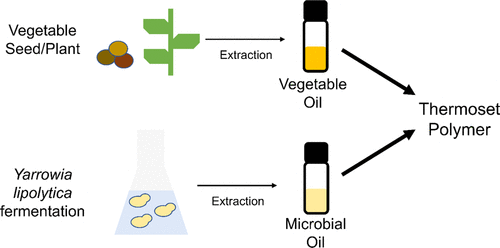当前位置:
X-MOL 学术
›
ACS Appl. Polym. Mater.
›
论文详情
Our official English website, www.x-mol.net, welcomes your feedback! (Note: you will need to create a separate account there.)
Data-Driven Approach to Decipher the Role of Triglyceride Composition on the Thermomechanical Properties of Thermosetting Polymers Using Vegetable and Microbial Oils
ACS Applied Polymer Materials ( IF 5 ) Pub Date : 2021-08-10 , DOI: 10.1021/acsapm.1c00486 Lauren T. Cordova 1 , Hannah Walton 2 , Eletria Biswas 2 , Khristal Monroe 2 , Rafael Quirino 2 , Hal S. Alper 1, 3
ACS Applied Polymer Materials ( IF 5 ) Pub Date : 2021-08-10 , DOI: 10.1021/acsapm.1c00486 Lauren T. Cordova 1 , Hannah Walton 2 , Eletria Biswas 2 , Khristal Monroe 2 , Rafael Quirino 2 , Hal S. Alper 1, 3
Affiliation

|
Sustainable and renewable polymeric materials are gaining traction, and vegetable oils have been used directly or in modified forms to meet this demand. At the same time, microbial hosts (such as the oleaginous yeast Yarrowia lipolytica) are being touted as sustainable alternatives for petroleum and vegetable oils. However, the exact role of fatty acid composition and speciation on polymer performance remains unclear. Here, we explore a data-driven approach to explicitly relate the underlying oil composition with the thermomechanical properties of the resulting polymeric material. In doing so, we identify the C16:0, C16:1, and C18:0 fatty acid contents of vegetable oils as critical parameters for predicting thermal stability at maximum heat loss (Tmax). Machine learning-based approaches were applied to study the link between thermal properties and monomer composition. In the end, application of multiple linear regression modeling indicated strong dependence on the C16:1 content as evident by the parameter loading (loading of +428 for Tmax). As a more sustainable source of oil, Y. lipolytica oil-based polymer properties were also dictated by the C16:0 and C18:0 fatty acid contents but with an opposite impact as compared with vegetable oils (Tmax loadings of −208 and +36 for Y. lipolytica oils, +19 and −72 for vegetable oils, C16:0 and C18:0, respectively). Despite these differences, Y. lipolytica oil-based polymers showed similar strength and cross-linking density to vegetable oil polymers. This work is the first evaluation of polymer properties from a library of vegetable- and yeast-sourced oils and highlights a mechanistic understanding of thermal stability from both oil source (vegetable or microbial) and oil composition that can be used for future design.
中文翻译:

使用植物油和微生物油解读甘油三酯组合物对热固性聚合物热机械性能的作用的数据驱动方法
可持续和可再生的聚合物材料越来越受欢迎,植物油已被直接使用或以改性形式使用以满足这一需求。与此同时,微生物宿主(如产油酵母解脂耶氏酵母)被吹捧为石油和植物油的可持续替代品。然而,脂肪酸组成和形态对聚合物性能的确切作用仍不清楚。在这里,我们探索了一种数据驱动的方法,以明确地将基础油成分与所得聚合物材料的热机械特性联系起来。在此过程中,我们将植物油的 C16:0、C16:1 和 C18:0 脂肪酸含量确定为预测最大热损失 ( T max)。应用基于机器学习的方法来研究热性能和单体组成之间的联系。最后,多元线性回归建模的应用表明对 C16:1 含量的强烈依赖,这从参数加载(T max 的加载为 +428 )可见一斑。作为一种更可持续的油源,解脂耶氏酵母油基聚合物的特性也受 C16:0 和 C18:0 脂肪酸含量的影响,但与植物油相比具有相反的影响(T max载荷为 -208 和 +解脂耶氏酵母油为 36,植物油为 +19 和 -72,分别为 C16:0 和 C18:0)。尽管存在这些差异,解脂耶氏酵母油基聚合物显示出与植物油聚合物相似的强度和交联密度。这项工作是对来自植物和酵母来源的油库的聚合物特性的首次评估,并突出了对油源(植物或微生物)和油成分的热稳定性的机械理解,可用于未来的设计。
更新日期:2021-09-10
中文翻译:

使用植物油和微生物油解读甘油三酯组合物对热固性聚合物热机械性能的作用的数据驱动方法
可持续和可再生的聚合物材料越来越受欢迎,植物油已被直接使用或以改性形式使用以满足这一需求。与此同时,微生物宿主(如产油酵母解脂耶氏酵母)被吹捧为石油和植物油的可持续替代品。然而,脂肪酸组成和形态对聚合物性能的确切作用仍不清楚。在这里,我们探索了一种数据驱动的方法,以明确地将基础油成分与所得聚合物材料的热机械特性联系起来。在此过程中,我们将植物油的 C16:0、C16:1 和 C18:0 脂肪酸含量确定为预测最大热损失 ( T max)。应用基于机器学习的方法来研究热性能和单体组成之间的联系。最后,多元线性回归建模的应用表明对 C16:1 含量的强烈依赖,这从参数加载(T max 的加载为 +428 )可见一斑。作为一种更可持续的油源,解脂耶氏酵母油基聚合物的特性也受 C16:0 和 C18:0 脂肪酸含量的影响,但与植物油相比具有相反的影响(T max载荷为 -208 和 +解脂耶氏酵母油为 36,植物油为 +19 和 -72,分别为 C16:0 和 C18:0)。尽管存在这些差异,解脂耶氏酵母油基聚合物显示出与植物油聚合物相似的强度和交联密度。这项工作是对来自植物和酵母来源的油库的聚合物特性的首次评估,并突出了对油源(植物或微生物)和油成分的热稳定性的机械理解,可用于未来的设计。


























 京公网安备 11010802027423号
京公网安备 11010802027423号